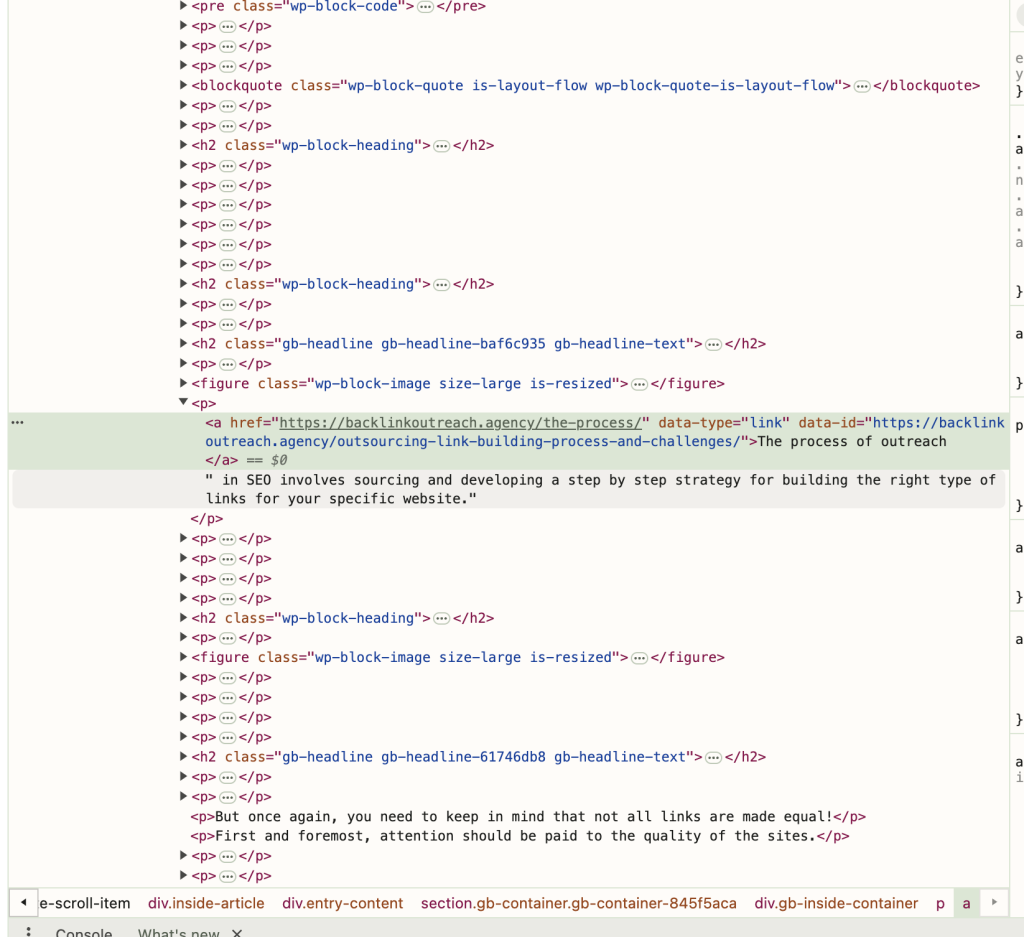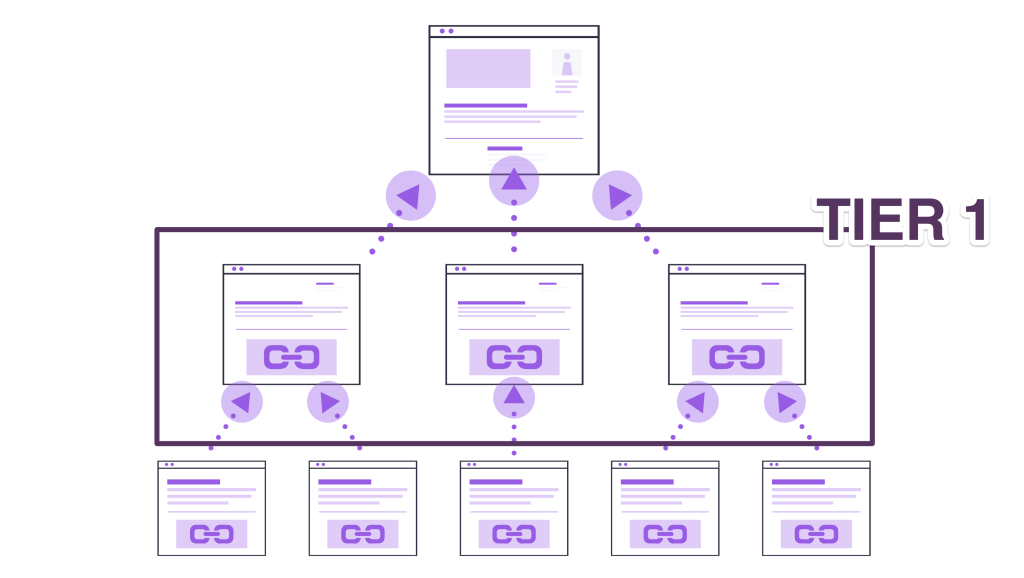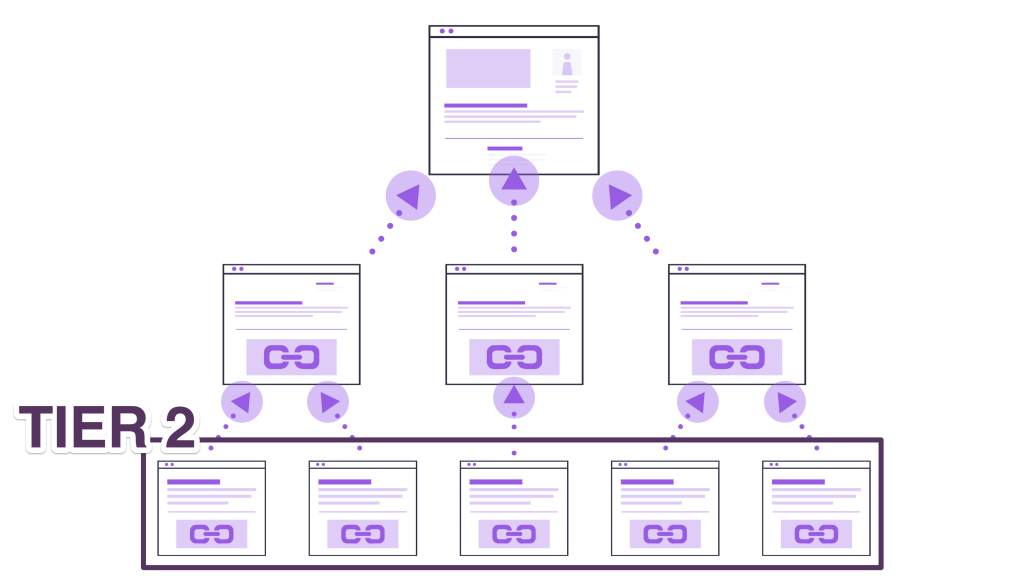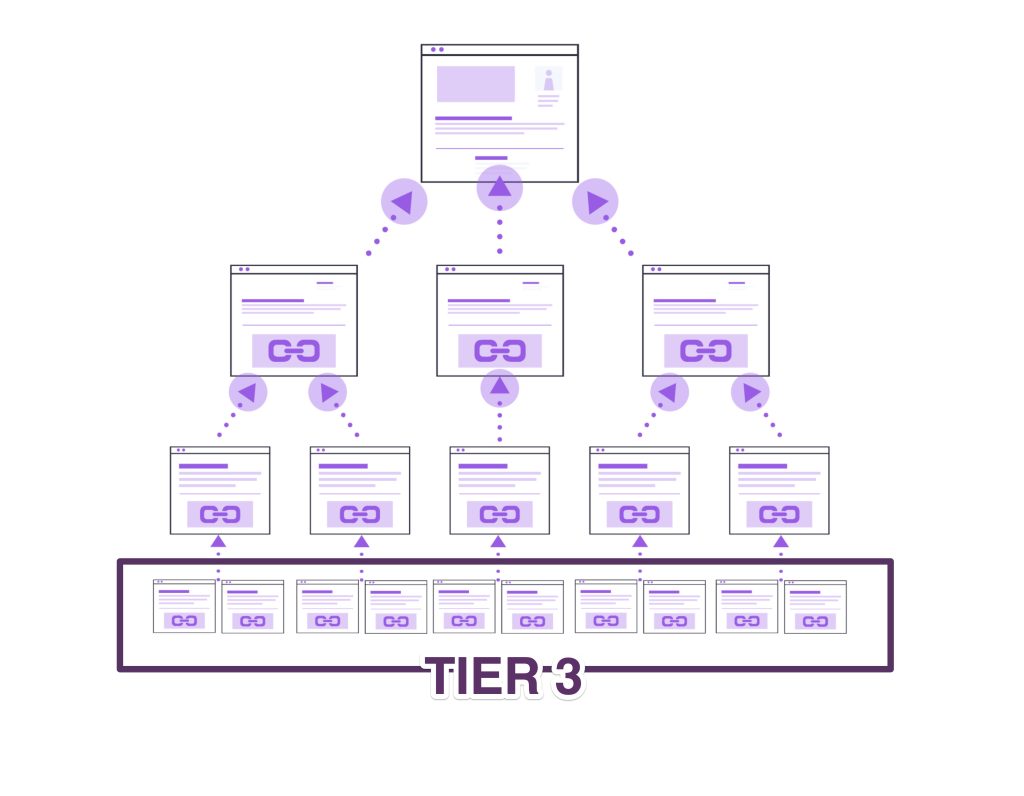What is Link Building?
The aim of link building is to increase the number and quality of inbound links to your website, in order to improve your Google rankings.
Link building is often described as the most important aspect of any search engine optimisation (SEO) strategy.
Hyperlinks, usually referred to just as links, are how users move between different pages online and are critical for search engine bots to crawl and index the web.
This critical aspect of any SEO strategy is focused on increasing the number and quality of inbound links to your website, with the goal of increasing its search engine rankings.
Ultimately, the process of link building involves obtaining hyperlinks from other websites that point back to your own domain.
Today, building high-quality backlinks is more than just acquiring links. It involves focusing on links from sites that demonstrate E-A-T (Expertise, Authoritativeness, Trustworthiness) to align with Google’s guidelines and improve credibility.
Link Structure – The Anatomy of a Link
When it comes to link building, we must first introduce link structure by looking at the URL contained within a website’s code.
The URL or web address published on another website that points back to your own looks as follows:
<a href="https://www.example.com/">Link text</a>
If the URL within the <a> tags points back to your website, then congratulations are in order, because you’ve successfully built a link!
But what you have to understand is that not all links are created equal.
The URL that is linking back to your site actually has a massive effect on the quality and trust that Google places on the backlink you’ve received.
The evaluation of a link goes beyond just its presence. Search engines assess the relevance, authority, and context of the linking domain. For instance, a backlink from a highly relevant industry site is far more valuable than one from an unrelated or low-authority source. Contextual links within relevant content can pass more link equity and signal to Google that the link is natural and valuable.
Think about it this way.
You would trust a major highly relevant industry site as a source than you would a part time blogger.
In order to ascertain the quality and thus strength that Google puts into a URL, it must dig deeper into the attributes assigned to each link.
One of the most common attributes that Google uses to interpret a link is the rel attribute that looks as follows:
<a href="https://www.example.com/" rel="nofollow">Link text</a>What the rel attribute does, is specify the relationship between the current and the linked URL.
In this example, the link has been defined as a “nofollow” link which indicates that Google should not use the link for page ranking calculations.
While it would technically be a backlink, the nofollow attribute lowers its authority.
Although nofollow links do not pass as much direct link equity, they can still play a strategic role. These links contribute to a diverse link profile, which appears more natural to search engines. Additionally, they can drive significant referral traffic and boost brand visibility when placed on high-traffic platforms such as Reddit, Quora, and major social media sites. This diversified approach can also signal a well-rounded backlink strategy that balances dofollow and nofollow links.
What we’re trying to show here is that when it comes to link building, it’s not a pure numbers game.
It takes quality content on your end and an extremely focused strategy on ours to build the right type of links to increase your Google ranking.
Organic Link Building
It’s this quality content of yours that is going to generate the majority of links pointing back to your site.
Best of all, these links are going to be generated organically, sent back your way simply because you provided value.
It’s these organic links that form a crucial basis for the entire world wide web, connecting related pages to provide the reader with value.
To maximize the potential for earning organic backlinks, focus on creating not just any content, but content that is interactive, data-driven, and highly shareable. This includes resources such as infographics, comprehensive white papers, in-depth industry studies, and interactive tools. These types of content are more likely to be referenced by authoritative sites because they provide unique value and insights that are difficult to replicate.
Another effective way to encourage organic backlinks is by fostering partnerships and co-authoring content with experts in your field. Collaborations can extend your content’s reach to their networks, enhancing your content’s credibility and linkability.
Organic link building is the holy grail of SEO, but is extremely hard to achieve at scale when you’re not a multinational brand.
Common Types of Link Building
Moving forward, let’s now go over the top three types of link building that we can help you undertake.
Focusing on the strategies required to successfully implement each in a safe way with minimal risk to your business.
Backlink Outreach
Outreach is an essential part of any link building strategy and will form one of the cornerstones of your entire SEO plan.
The process of outreach in SEO involves sourcing and developing a step by step strategy for building the right type of links for your specific website.
Outreach results in receiving valuable links from these specifically related websites that link back to your site.
Modern outreach strategies benefit from the integration of tools such as Ahrefs, Link Assistant Hunter.io, which streamline the process of identifying relevant contacts and managing outreach. Additionally, using AI-driven solutions can help craft personalized email templates, automate follow-ups, and track response rates, making campaigns more effective and scalable.
As we’ve discussed above, not all backlinks are created equal and it takes sourcing the right type of links to be truly helpful in boosting your organic rankings.
Working with us will supercharge your outreach, allowing you to tap into our extensive network of partner websites to form the relationships required to build backlinks.
Tiered Link Building
Following on from your outreach, a tiered link building approach is a strategy that involves building backlinks to your backlinks.

By creating and building tiered links in bulk, your webpage is positioned at the end of the chain, thereby passing link juice to your own webpage.

Basically, you have a tier 1 backlink pointing to your main website, a few tier 2 backlinks pointing to the tier 1 backlinks, and a few tier 3 backlinks pointing to each tier 2 backlink.

This specific link building strategy helps to remove the risks associated with receiving non-organic links by adding an extra layer, but structures them in a way to ultimately target the link juice toward your site. It’s especially valuable in highly competitive niches i.e gambling or crypto.
This complex link building strategy is one that if correctly implemented by our team of experienced professionals, can be the difference between a page two and page one Google ranking.
Reddit, Quora, and specialized industry communities
Sourcing forum/social links is a classic link building strategy that if implemented correctly, can still offer value.
As its name suggests, the process involves building your own links via posting on popular industry specific forums, social networks and community websites.
But once again, you need to keep in mind that not all links are made equal!
First and foremost, attention should be paid to the quality of the sites.
Despite the limitations of nofollow links, participating in niche forums and Q&A platforms like Reddit, Quora, and specialized industry communities can significantly enhance brand visibility and drive targeted referral traffic. Engaging thoughtfully in discussions and providing valuable input can establish your expertise and foster trust with potential site visitors.
We help you not only source forums and communities which offer valuable links, but work with you to strategically place links that will leverage their own rankings to drive traffic to your site.
Final Thoughts on Link Building
It is widely accepted that link building is the most important aspect of your SEO strategy.
With that being said however, it’s imperative that you go about building links in a natural way, using white hat strategies that put the most emphasis on building organic links thanks to the quality of your content.
Leveraging our trusted relationships via outreach then supported by some of the popular link building strategies outlined above can supplement your efforts with minimal risk.
But the focus must always remain on building your own library of quality content.
By focusing on the quality and depth of your own content, organic link building will ultimately scale to the point that its value overtakes your supporting link building strategies.
This is the ultimate end game.
Services
Backlink Outreach (40h)
Focused on startups & small businesses. The hourly rate covers website selection, metrics evaluation, contact discovery, and negotiation. Typical outcome: 4–8 quality backlinks per month. Client Terms: All publishing costs are paid directly to the publisher. Every site is pre-approved by the client before placement.
5 High Quality Backlinks
You will receive 5 guaranteed backlinks with Ahrefs DR > 40 and Organic Traffic > 4000. Content creation is included. All websites are niche-relevant and pre-approved. Fixed price package, no hidden costs.
Tiered Link Building
Tiered link building turnkey service. The base cost of the service is indicated. The price may vary depending on your site’s niche and additional client requests.